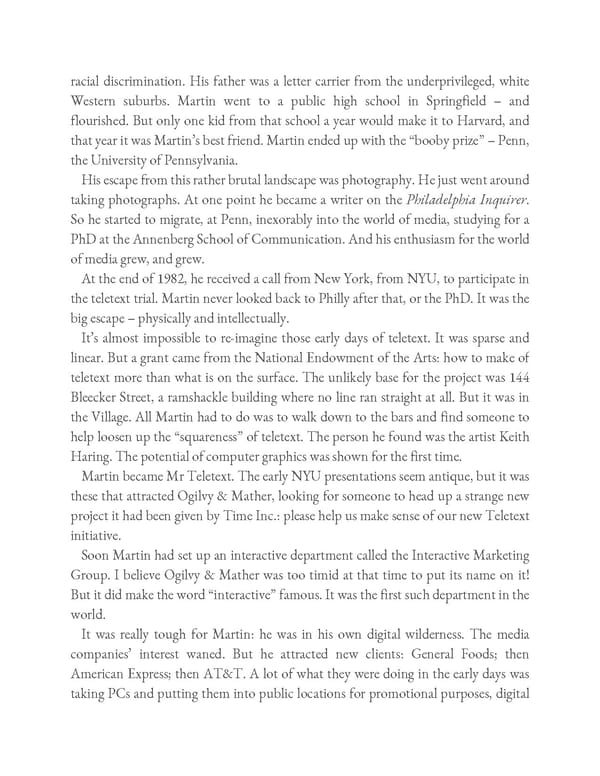racial discrimination. His father was a letter carrier from the underprivileged, white Western suburbs. Martin went to a public high school in Springfield – and flourished. But only one kid from that school a year would make it to Harvard, and that year it was Martin’s best friend. Martin ended up with the “booby prize” – Penn, the University of Pennsylvania. His escape from this rather brutal landscape was photography. He just went around taking photographs. At one point he became a writer on the Philadelphia Inquirer. So he started to migrate, at Penn, inexorably into the world of media, studying for a PhD at the Annenberg School of Communication. And his enthusiasm for the world of media grew, and grew. At the end of 1982, he received a call from New York, from NYU, to participate in the teletext trial. Martin never looked back to Philly after that, or the PhD. It was the big escape – physically and intellectually. It’s almost impossible to re-imagine those early days of teletext. It was sparse and linear. But a grant came from the National Endowment of the Arts: how to make of teletext more than what is on the surface. The unlikely base for the project was 144 Bleecker Street, a ramshackle building where no line ran straight at all. But it was in the Village. All Martin had to do was to walk down to the bars and find someone to help loosen up the “squareness” of teletext. The person he found was the artist Keith Haring. The potential of computer graphics was shown for the first time. Martin became Mr Teletext. The early NYU presentations seem antique, but it was these that attracted Ogilvy & Mather, looking for someone to head up a strange new project it had been given by Time Inc.: please help us make sense of our new Teletext initiative. Soon Martin had set up an interactive department called the Interactive Marketing Group. I believe Ogilvy & Mather was too timid at that time to put its name on it! But it did make the word “interactive” famous. It was the first such department in the world. It was really tough for Martin: he was in his own digital wilderness. The media companies’ interest waned. But he attracted new clients: General Foods; then American Express; then AT&T. A lot of what they were doing in the early days was taking PCs and putting them into public locations for promotional purposes, digital
 Ogilvy on Advertising in the Digital Age Page 374 Page 376
Ogilvy on Advertising in the Digital Age Page 374 Page 376